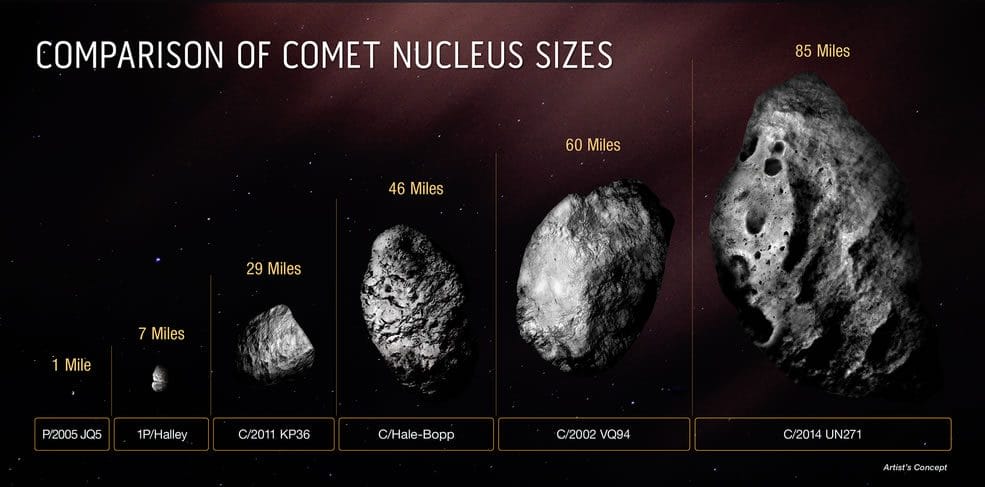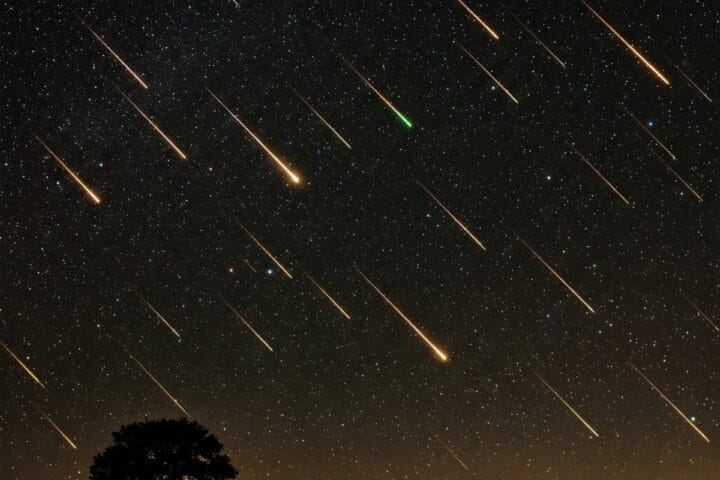NASA’s Hubble Space Telescope has determined the size of the largest icy comet nucleus ever seen by astronomers. The estimated diameter is approximately 80 miles across, making it larger than the state of Rhode Island. The nucleus is about 50 times larger than found at the heart of most known comets. Its mass is estimated to be a staggering 500 trillion tons, a hundred thousand times greater than the mass of a typical comet found much closer to the Sun.
The behemoth comet, C/2014 UN271 (Bernardinelli-Bernstein) is barreling this way at 22,000 miles per hour from the edge of the solar system. But not to worry. It will never get closer than 1 billion miles away from the Sun, which is slightly farther than the distance of the planet Saturn. And that won’t be until the year 2031.
The previous record holder is comet C/2002 VQ94, with a nucleus estimated to be 60 miles across. It was discovered in 2002 by the Lincoln Near-Earth Asteroid Research (LINEAR) project.
“This comet is literally the tip of the iceberg for many thousands of comets that are too faint to see in the more distant parts of the solar system,” said David Jewitt, a professor of planetary science and astronomy at the University of California, Los Angeles (UCLA), and co-author of the new study in The Astrophysical Journal Letters. “We’ve always suspected this comet had to be big because it is so bright at such a large distance. Now we confirm it is.”
Comet C/2014 UN271 was discovered by astronomers Pedro Bernardinelli and Gary Bernstein in archival images from the Dark Energy Survey at the Cerro Tololo Inter-American Observatory in Chile. It was first serendipitously observed in November 2010, when it was a whopping 3 billion miles from the Sun, which is nearly the average distance to Neptune. Since then, it has been intensively studied by ground and space-based telescopes.
“This is an amazing object, given how active it is when it’s still so far from the Sun,” said the paper’s lead author Man-To Hui of the Macau University of Science and Technology, Taipa, Macau. “We guessed the comet might be pretty big, but we needed the best data to confirm this.” So, his team used Hubble to take five photos of the comet on January 8, 2022.
The challenge in measuring this comet was how to discriminate the solid nucleus from the huge dusty coma enveloping it. The comet is currently too far away for its nucleus to be visually resolved by Hubble. Instead, the Hubble data show a bright spike of light at the nucleus’ location. Hui and his team next made a computer model of the surrounding coma and adjusted it to fit the Hubble images. Then, the glow of the coma was subtracted to leave behind the starlike nucleus.
Hui and his team compared the brightness of the nucleus to earlier radio observations from the Atacama Large Millimeter/submillimeter Array (ALMA) in Chile. This combined data constrains the diameter and the reflectivity of the nucleus. The new Hubble measurements are close to the earlier size estimates from ALMA, but convincingly suggest a darker nucleus surface than previously thought. “It’s big and it’s blacker than coal,” said Jewitt.

The comet has been falling toward the Sun for well over 1 million years. It is coming from the hypothesized nesting ground of trillions of comets, called the Oort Cloud. The diffuse cloud is thought to have an inner edge at 2,000 to 5,000 times the distance between the Sun and the Earth. Its outer edge might extend at least a quarter of the way out to the distance of the nearest stars to our Sun, the Alpha Centauri system.
The Oort Cloud’s comets didn’t actually form so far from the Sun; instead, they were tossed out of the solar system billions of years ago by a gravitational “pinball game” among the massive outer planets, when the orbits of Jupiter and Saturn were still evolving. The far-flung comets only travel back toward the Sun and planets if their distant orbits are disturbed by the gravitational tug of a passing star – like shaking apples out of a tree.
Comet Bernardinelli-Bernstein follows a 3-million-year-long elliptical orbit, taking it as far from the Sun as roughly half a light-year. The comet is now less than 2 billion miles from the Sun, falling nearly perpendicular to the plane of our solar system. At that distance temperatures are only about minus 348 degrees Fahrenheit. Yet that’s warm enough for carbon monoxide to sublimate off the surface to produce the dusty coma.
Comet Bernardinelli-Bernstein provides an invaluable clue to the size distribution of comets in the Oort Cloud and hence its total mass. Estimates for the Oort Cloud’s mass vary widely, reaching as high as 20 times Earth’s mass.
First hypothesized in 1950 by Dutch astronomer Jan Oort, the Oort Cloud still remains a theory because the innumerable comets that make it up are too faint and distant to be directly observed. Ironically, this means the solar system’s largest structure is all but invisible. It’s estimated that NASA’s pair of Voyager spacecraft won’t reach the inner realm of the Oort Cloud for another 300 years and could take as long as 30,000 years to pass through it.
Circumstantial evidence come from infalling comets that can be traced back to this nesting ground. They approach the Sun from all different directions meaning the cloud must be spherical in shape. These comets are deep-freeze samples of the composition of the early solar system, preserved for billions of years. The reality of the Oort Cloud is bolstered by theoretical modeling of the formation and evolution of the solar system. The more observational evidence that can be gathered through deep sky surveys coupled with multiwavelength observations, the better astronomers will understand the Oort Cloud’s role in the solar system’s evolution.
The Hubble Space Telescope is a project of international cooperation between NASA and ESA (European Space Agency). NASA’s Goddard Space Flight Center in Greenbelt, Maryland, manages the telescope. The Space Telescope Science Institute (STScI) in Baltimore, Maryland, conducts Hubble science operations. STScI is operated for NASA by the Association of Universities for Research in Astronomy, in Washington, D.C.
Source: NASA











